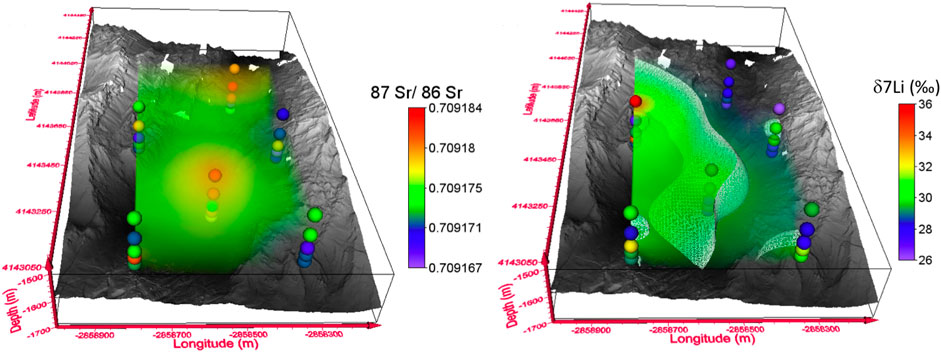- 1Institut des Sciences Analytiques et de Physico-chimie pour l’Environnement et les matériaux, Universite de Pau et des Pays de l’Adour, E2S UPPA, CNRS, IPREM, Pau, France
- 2Laboratoire Océanographique de Villefranche-sur-Mer (LOV), CNRS, Sorbonne Universite, Villefranche-sur-Mer, France
Editorial on the Research Topic
Advances in metals and trace elements isotopes measurements, experiments and application in environmental sciences
The isotopic composition of trace metals and elements can be used to characterize their sources of emission and to trace the physicochemical or biological processes that these elements undergo. Precise measurements of trace metals and their isotopic compositions are pre-required for such research issues. Regarding the processes leading to fractionation between isotopes and thereby to a modification of the isotopic composition, the main mechanisms of isotopic fractionations result from physicochemical reactions such as redox transformations, the dissolution or precipitation of minerals and/or neoformed phases (eg. oxy-hydroxides). Added to this are the effects associated with living organisms that, for their development, can integrate metals into their metabolism and be also the cause of strong isotopic fractionations. The development of multi-collector inductively coupled plasma instruments (MC-ICP-MS) has made it possible to accurately and repeatably measure the isotopic composition of trace metals and elements whose (small) variations in isotopic abundance obey the laws of mass dependent fractionation. In addition, few non-traditional elements, such as Hg, have been identified to exhibit specific isotopic fractionation that do not follow such basic rules (i.e. mass independent isotopic fractionation).
This Research Topic aimed to promote specific studies on stable and meta-stable isotopes of metals and trace elements that have been recently developed and integrated into environmental sciences and pollution research. Isotopic composition of trace metals and elements requires methodological development in order to be applicable to various environments from pristine to more polluted areas. In addition, the isotopic information should provide unique insight into both their environmental sources and their physico-chemical or biological pathways. Altogether, isotopic composition combined with speciation of trace elements and metals are important information that could be used to investigate their pathways and impact.
The scope of this Research Topic, was thus to address specific investigations related, to both trace elements and metals method developments and to the study of their potential applications in environmental and pollution sciences. This special issue covered a wide range of isotope systems, from non-traditional stable isotopes (Lacan et al.; Artigue et al.; Pinzone et al.) to radiogenic systems (Yamakawa et al.; Artigue et al.; Pham et al.). It includes papers showing fine analytical developments for isotopic measurements and for validation with reference materials (Lacan et al.; Yamakawa et al.). One study unravels the trophic transfer and impact of metabolic processes on Hg isotopes (Pinzone et al.). Another study demonstrates the possibility to use Li and Sr isotopes (Figure 1) to monitor in barely documented extreme environments the extent of deep hydrothermal plumes (Artigue et al.). Finally the coupling of Nd isotopes with hydrological tracers in Equatorial Pacific allows to highlight land-ocean interactions affecting specific water layers (Pham et al.). These original investigations open new avenues of research in environmental sciences combining stable and radiogenic isotopes of trace metals and elements.

FIGURE 1. Simultaneous investigation of Sr radiogenic isotopic ratios and Li stable isotopic composition in deep-sea layers affected by hydrothermal inputs (adapted from (Artigue et al.)).
Author contributions
DA and NV wrote the editorial text and select the figure.
Conflict of interest
The authors declare that the research was conducted in the absence of any commercial or financial relationships that could be construed as a potential conflict of interest.
Publisher’s note
All claims expressed in this article are solely those of the authors and do not necessarily represent those of their affiliated organizations, or those of the publisher, the editors and the reviewers. Any product that may be evaluated in this article, or claim that may be made by its manufacturer, is not guaranteed or endorsed by the publisher.
Keywords: metals, trace element, isotopes, environment, pollution, biogeochemistry, fractionation
Citation: Amouroux D and Vigier N (2022) Editorial: Advances in metals and trace elements isotopes measurements, experiments and application in environmental sciences. Front. Environ. Chem. 3:1046468. doi: 10.3389/fenvc.2022.1046468
Received: 16 September 2022; Accepted: 22 September 2022;
Published: 10 October 2022.
Edited and reviewed by:
Robert Peter Mason, University of Connecticut, United StatesCopyright © 2022 Amouroux and Vigier. This is an open-access article distributed under the terms of the Creative Commons Attribution License (CC BY). The use, distribution or reproduction in other forums is permitted, provided the original author(s) and the copyright owner(s) are credited and that the original publication in this journal is cited, in accordance with accepted academic practice. No use, distribution or reproduction is permitted which does not comply with these terms.
*Correspondence: David Amouroux, ZGF2aWQuYW1vdXJvdXhAdW5pdi1wYXUuZnI=; Nathalie Vigier, bmF0aGFsaWUudmlnaWVyQG9icy12bGZyLmZy
 David Amouroux
David Amouroux Nathalie Vigier
Nathalie Vigier